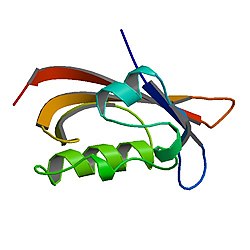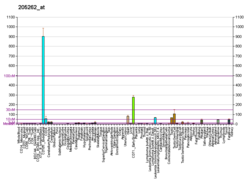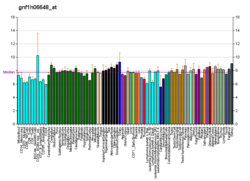hERG (the human Ether-à-go-go-Related Gene) is a gene (KCNH2) that codes for a protein known as Kv11.1, the alpha subunit of a potassium ion channel. This ion channel (sometimes simply denoted as 'hERG') is best known for its contribution to the electrical activity of the heart: the hERG channel mediates the repolarizing IKr current in the cardiac action potential, which helps coordinate the heart's beating.
When this channel's ability to conduct electrical current across the cell membrane is inhibited or compromised, either by application of drugs or by rare mutations in some families,[5] it can result in a potentially fatal disorder called long QT syndrome. Conversely, genetic mutations that increase the current through these channels can lead to the related inherited heart rhythm disorder short QT syndrome.[6] A number of clinically successful drugs in the market have had the tendency to inhibit hERG, lengthening the QT and potentially leading to a fatal irregularity of the heartbeat (a ventricular tachyarrhythmia called torsades de pointes). This has made hERG inhibition an important antitarget that must be avoided during drug development.[7]
hERG has also been associated with modulating the functions of some cells of the nervous system[8][9] and with establishing and maintaining cancer-like features in leukemic cells.[10]
- ^ a b c GRCh38: Ensembl release 89: ENSG00000055118 – Ensembl, May 2017
- ^ a b c GRCm38: Ensembl release 89: ENSMUSG00000038319 – Ensembl, May 2017
- ^ "Human PubMed Reference:". National Center for Biotechnology Information, U.S. National Library of Medicine.
- ^ "Mouse PubMed Reference:". National Center for Biotechnology Information, U.S. National Library of Medicine.
- ^ Hedley PL, Jørgensen P, Schlamowitz S, Wangari R, Moolman-Smook J, Brink PA, et al. (November 2009). "The genetic basis of long QT and short QT syndromes: a mutation update". Human Mutation. 30 (11): 1486–1511. doi:10.1002/humu.21106. PMID 19862833. S2CID 19122696.
- ^ Bjerregaard P (August 2018). "Diagnosis and management of short QT syndrome". Heart Rhythm. 15 (8): 1261–1267. doi:10.1016/j.hrthm.2018.02.034. PMID 29501667. S2CID 4519580.
- ^ Sanguinetti MC, Tristani-Firouzi M (March 2006). "hERG potassium channels and cardiac arrhythmia". Nature. 440 (7083): 463–469. Bibcode:2006Natur.440..463S. doi:10.1038/nature04710. PMID 16554806. S2CID 929837.
- ^ Chiesa N, Rosati B, Arcangeli A, Olivotto M, Wanke E (June 1997). "A novel role for HERG K+ channels: spike-frequency adaptation". The Journal of Physiology. 501 (Pt 2): 313–318. doi:10.1111/j.1469-7793.1997.313bn.x. PMC 1159479. PMID 9192303.
- ^ Overholt JL, Ficker E, Yang T, Shams H, Bright GR, Prabhakar NR (2002). "Chemosensing at the Carotid Body". Oxygen Sensing. Advances in Experimental Medicine and Biology. Vol. 475. pp. 241–248. doi:10.1007/0-306-46825-5_22. ISBN 978-0-306-46367-9. PMID 10849664.
- ^ Arcangeli A (2005). "Expression and Role of hERG Channels in Cancer Cells". The hERG Cardiac Potassium Channel: Structure, Function and Long QT Syndrome. Novartis Foundation Symposia. Vol. 266. pp. 225–32, discussion 232–4. doi:10.1002/047002142X.ch17. ISBN 9780470021408. PMID 16050271.







